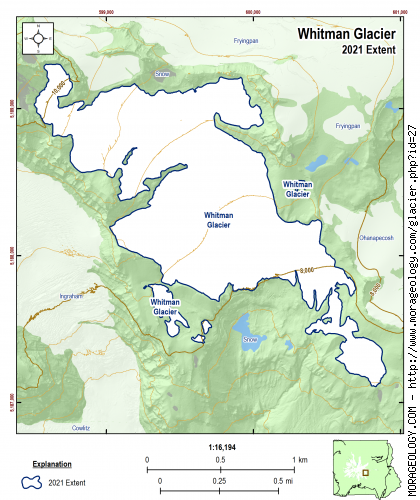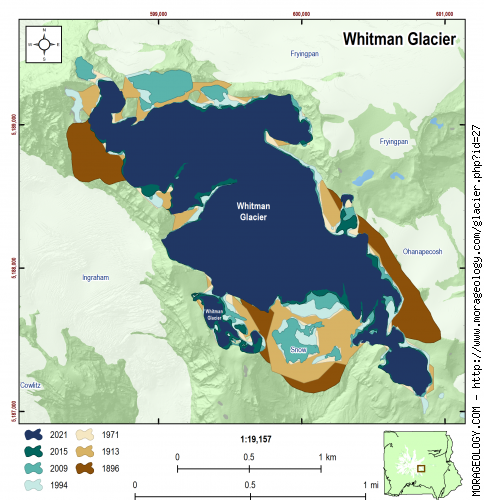NOTE: The data shown here is based on the 2021 glacier update at Mount Rainier, and should be considered the most up-to-date data on glaciers at the park (2023-04-06).
Whitman Glacier
This glacier on the east side of Mount Rainier was named for Marcus Whitman, the missionary. He was born in Rushville, New York, on September 4, 1802, received medical training and in 1835 made a missionary reconnaissance to Oregon. He married Narcissa Prentiss and with others made the first journey on the Oregon Trail by women. He and his family were killed by Cayuse Indians on November 29, 1847. (Reese, 2009)
Switch Glacier:

|
STATISTICS AS OF 2021 (Beason et al., 2023):
Aerial Extent:
0.713 ± 0.040 square miles
(1.846 ± 0.104 km2)
(Rank: 15 of 29)
Debris Cover - Based on data from 2015 (Beason, 2017):
0.001 ± 0.000 square miles
(0.001 ± 0.000 km2)
(Rank: 19 of 29)
Estimated Glacier Volume: (See notes below)
0.0187 ± 0.0065 cubic miles
(0.0779 ± 0.0273 km3)
Highest Elevation (Head):
10,286 feet
(3,135 m)
Lowest Elevation (Terminus):
7,579 feet
(2,310 m)
Elevation Range:
2,707 feet
(825 m)
Length:
2.02 miles
(3.25 km)
Average Slope:
16.40°
Average Flow Direction (direction the glacier flows towards):
Southeast (142°)
Glacier Type:
C - Cirque Glacier, or Glacier Head Starts Below Summit |

|
CHANGE IN EXTENT, 1896-2021 (Beason et al., 2023):
| Units |
1896 |
1913 |
1971 |
1994 |
2009 |
2015 |
2021 |
| Area, mi2 |
0.762 |
0.939 |
0.859 |
0.894 |
0.811 |
0.749 |
0.713 |
| Area, km2 |
1.974 |
2.432 |
2.226 |
2.315 |
2.101 |
1.939 |
1.846 |
Area Change Between Periods
|
1913 |
1971 |
1994 |
2009 |
2015 |
2021 |
| 1896 | 0.177 mi2
(0.458 km2) | 0.097 mi2
(0.251 km2) | 0.132 mi2
(0.341 km2) | 0.049 mi2
(0.127 km2) | -0.014 mi2
(-0.036 km2) | -0.050 mi2
(-0.129 km2) |
|---|
| 1913 | -- | -0.080 mi2
(-0.207 km2) | -0.045 mi2
(-0.117 km2) | -0.128 mi2
(-0.331 km2) | -0.190 mi2
(-0.493 km2) | -0.226 mi2
(-0.586 km2) |
|---|
| 1971 | | -- | 0.035 mi2
(0.089 km2) | -0.048 mi2
(-0.124 km2) | -0.111 mi2
(-0.287 km2) | -0.147 mi2
(-0.380 km2) |
|---|
| 1994 | | | -- | -0.082 mi2
(-0.214 km2) | -0.145 mi2
(-0.376 km2) | -0.181 mi2
(-0.469 km2) |
|---|
| 2009 | | | | -- | -0.063 mi2
(-0.163 km2) | -0.099 mi2
(-0.256 km2) |
|---|
| 2015 | | | | | -- | -0.036 mi2
(-0.093 km2) |
|---|
Percent Change Between Periods
|
1913 |
1971 |
1994 |
2009 |
2015 |
2021 |
| 1896 | 23.18% | 12.72% | 17.25% | 6.43% | -1.81% | -6.52% |
|---|
| 1913 | -- | -8.49% | -4.81% | -13.60% | -20.28% | -24.11% |
|---|
| 1971 | | -- | 4.02% | -5.58% | -12.89% | -17.07% |
|---|
| 1994 | | | -- | -9.23% | -16.25% | -20.27% |
|---|
| 2009 | | | | -- | -7.74% | -12.17% |
|---|
| 2015 | | | | | -- | -4.80% |
|---|
|
|
ESTIMATED CHANGE IN VOLUME, 1896-2021 (Beason et al., 2023):
PLEASE see important notes about this, below...
Glacier-specific Scaling Parameter, c:
0.041847
| Units |
1896 |
1913 |
1971 |
1994 |
2009 |
2015 |
2021 |
| Volume, mi3 |
0.0205 |
0.0273 |
0.0242 |
0.0255 |
0.0223 |
0.0200 |
0.0187 |
| Volume, km3 |
0.0855 |
0.1137 |
0.1007 |
0.1063 |
0.0931 |
0.0834 |
0.0779 |
Volume Change Between Periods
|
1913 |
1971 |
1994 |
2009 |
2015 |
2021 |
| 1896 | 0.007 mi3
(0.028 km3) | 0.004 mi3
(0.015 km3) | 0.005 mi3
(0.021 km3) | 0.002 mi3
(0.008 km3) | -0.001 mi3
(-0.002 km3) | -0.002 mi3
(-0.008 km3) |
|---|
| 1913 | -- | -0.003 mi3
(-0.013 km3) | -0.002 mi3
(-0.007 km3) | -0.005 mi3
(-0.021 km3) | -0.007 mi3
(-0.030 km3) | -0.009 mi3
(-0.036 km3) |
|---|
| 1971 | | -- | 0.001 mi3
(0.006 km3) | -0.002 mi3
(-0.008 km3) | -0.004 mi3
(-0.017 km3) | -0.005 mi3
(-0.023 km3) |
|---|
| 1994 | | | -- | -0.003 mi3
(-0.013 km3) | -0.005 mi3
(-0.023 km3) | -0.007 mi3
(-0.028 km3) |
|---|
| 2009 | | | | -- | -0.002 mi3
(-0.010 km3) | -0.004 mi3
(-0.015 km3) |
|---|
| 2015 | | | | | -- | -0.001 mi3
(-0.005 km3) |
|---|
Percent Change Between Periods
|
1913 |
1971 |
1994 |
2009 |
2015 |
2021 |
| 1896 | 33.04% | 17.82% | 24.35% | 8.91% | -2.47% | -8.82% |
|---|
| 1913 | -- | -11.44% | -6.53% | -18.14% | -26.69% | -31.46% |
|---|
| 1971 | | -- | 5.55% | -7.56% | -17.21% | -22.61% |
|---|
| 1994 | | | -- | -12.42% | -21.56% | -26.67% |
|---|
| 2009 | | | | -- | -10.44% | -16.28% |
|---|
| 2015 | | | | | -- | -6.51% |
|---|
Important comments about the calculation of volume shown here
The calculation of glacial volume shown on this page is based on an analysis of two methods used at Mount Rainier in the past (Driedger and Kennard [1986]; and Nylen [2001]) as well as the most recent literature review for glacier area-volume scaling (Please review Beason et al. [2023] for an in-depth discussion about this issue). It should be noted that simply converting area to volume with an equation is extremely difficult and the values presented here have extremely large error margins (likely ± 35% or more). With that in mind, the values presented here should give you an estimate of the glacial volume and change in volume over time. Please use these data very carefully with those caveats.
The calcuation of the volume is as follows:
\[V_i = {(c_iA_i^{1.375}) + (c_nA_i^{1.36}) \over 2}\]
Where:
\(V_i\) = Average volume for the glacier in question (km3);
\(c_i\) = The glacier-specific scaling parameter (back-calculated from glacier area and volume in 1971 in Driedger and Kennard (1986); Method described in Beason et al. (2023). The value for the Whitman Glacier is 0.041847 (this is also listed above the volume graph);
\(c_n\) = The back-calculated scaling parameter from Nylen (2001) of 0.0255; and
\(A_i\) = The measured volume of the glacier in question (km2).
This is essentially an average of the back-calculated Dreidger and Kennard (1986) and Nylen (2001) methods (D&K is in the first parenthesis; Nylen in the second). For example, for the Whitman Glacier in 2021, you can find the following individual volumes:
Back-calculated Dreidger and Kennard (1986) Method: 0.0233 mi3 (0.0972 km3).
Back-calculated Nylen (2001) Method: 0.0141 mi3 (0.0587 km3).
Average of the two (above equation and values listed for 2021 here): 0.0187 mi3 (0.0779 km3).
Official volume estimate listed above, with error: 0.0187 ± 0.0065 mi3 (0.0779 ± 0.0273 km3).
As you can see, the D&K method tends to produce higher values and Nylen produces lower values; the average of these two methods probably estimates the glacial volume. Until further research is done in this area and we can develop a better method or equation to determine volumes, this is the method we are using to determine glacial volumes. For more information about this method, please read the methods section of Beason et al. (2023).
|
NOTES:
-- No Notes supplied --
RAW DATA: